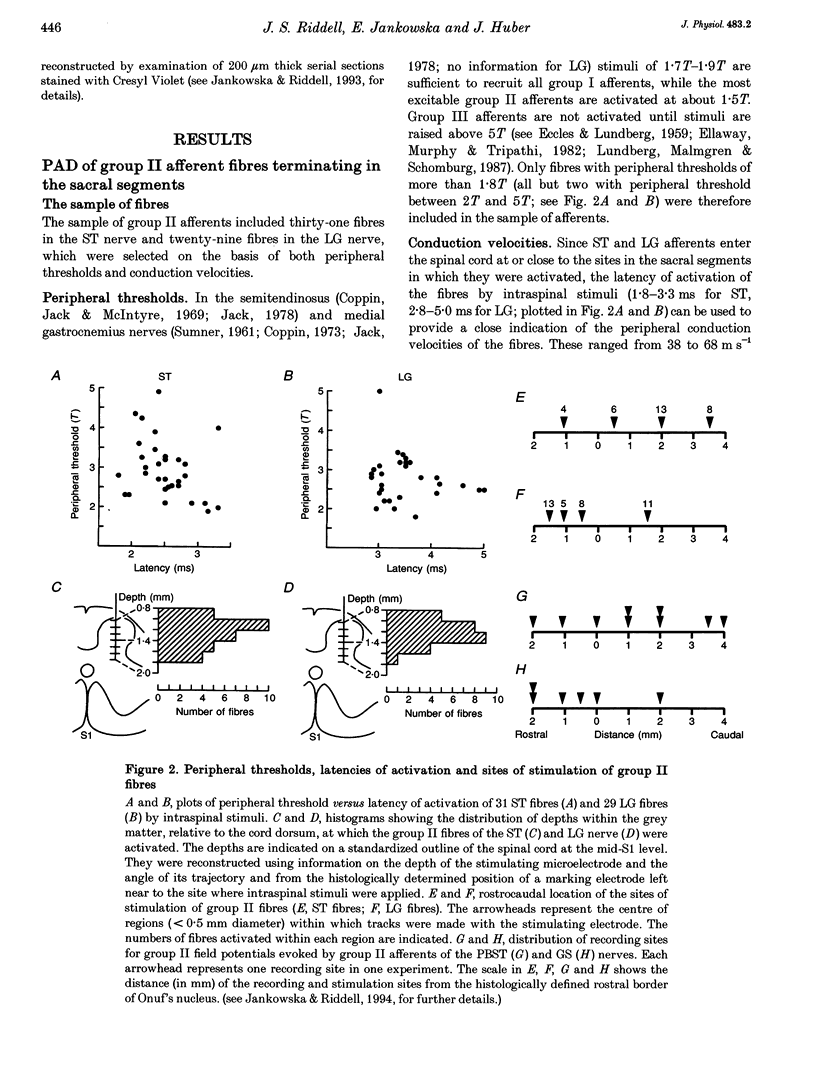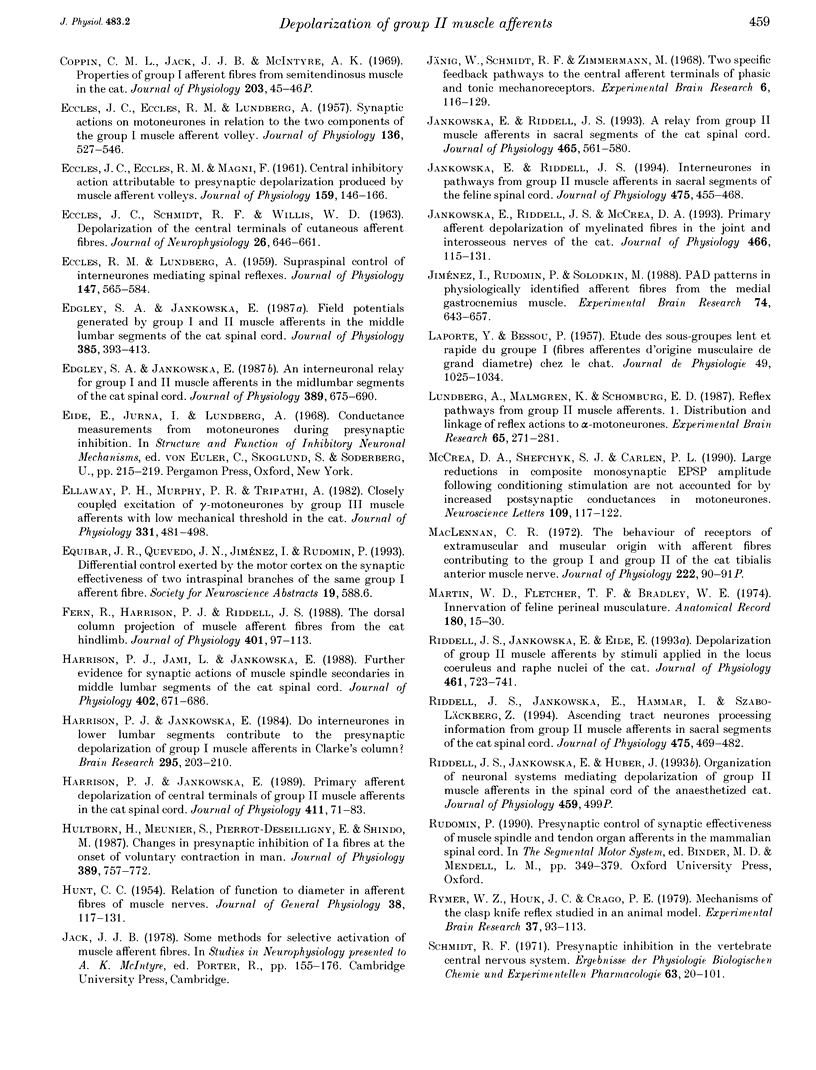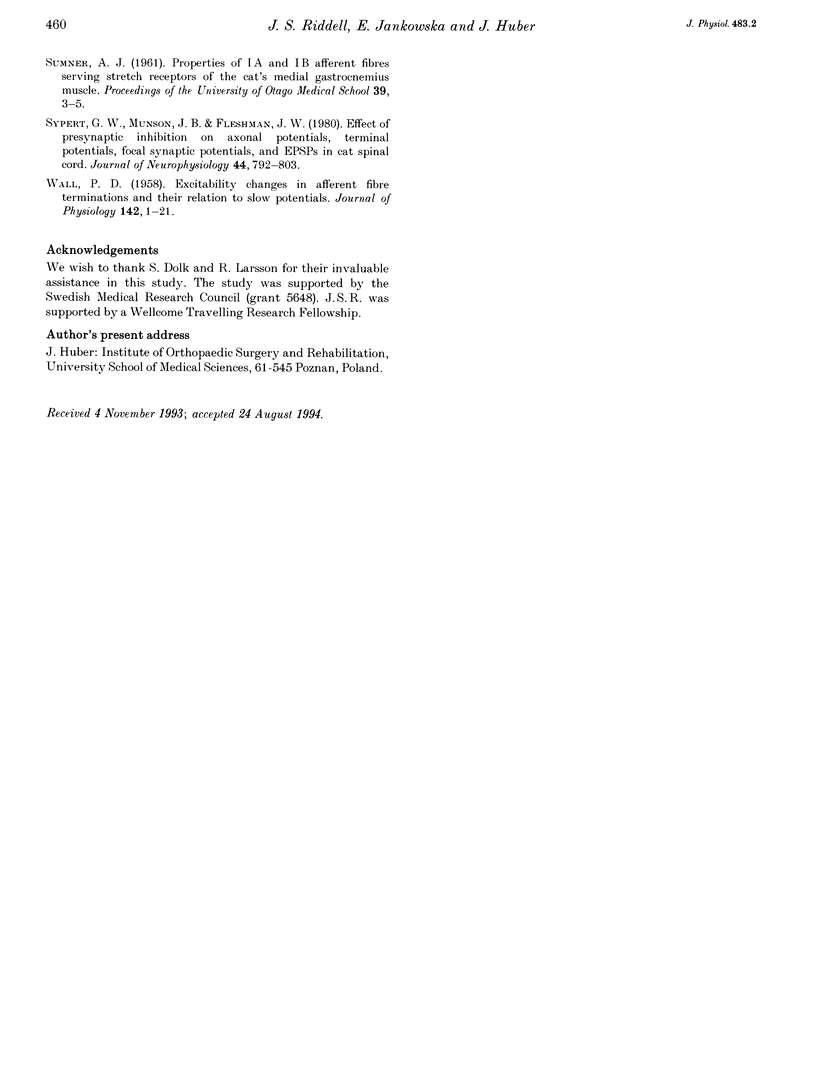Abstract
1. The organization of neuronal systems mediating presynaptic control of transmission from group II muscle afferent fibres has been investigated by comparing the sources of presynaptic inhibition of fibres terminating in different segments of the spinal cord: fibres of the semitendinosus and lateral gastrocnemius muscle nerves terminating in the sacral segments and of the tibialis anterior and extensor digitorum longus muscle nerves terminating in the midlumbar segments. 2. Two measures of presynaptic inhibition were used: depolarization of the terminals of group II fibres (detected as changes in the excitability of single fibres to electrical stimuli) and a decrease in the effectiveness of their synaptic actions (detected as a decrease in the amplitude of monosynaptic field potentials evoked by group II muscle afferents). 3. Group II muscle afferents strongly depolarized all of the group II afferent fibres, while group I muscle afferents contributed to the depolarization of only a few. The majority of fibres were as effectively depolarized by cutaneous afferents as by the most effective muscle afferents. However, the effectiveness with which afferents of different nerves depolarized group II muscle afferent fibres in the sacral and midlumbar segments differed. The most effective afferents were those of nerves that provide the main input to dorsal horn interneurones in the same region of the spinal cord. The sources of depolarization of flexor and extensor fibres terminating in the same (sacral) segments were very similar. 4. The amplitudes of field potentials evoked by group II afferents were depressed by the same types of afferent as produced depolarization of group II afferent fibres. There was also a strong correlation between the effectiveness with which afferents of a given nerve induced depolarization of single fibres and depression of field potentials in the same segments. Since group II field potentials were depressed to a greater extent (by up to 90%) than group I field potentials (by no more than 20%) concurrently recorded in the intermediate zone of midlumbar segments, it appears that transmission from group II muscle afferents may be more strongly affected by presynaptic inhibition than that from group I muscle afferents. 5. The results suggest that the interneuronal systems responsible for the presynaptic control of transmission from group II muscle afferents have topographically restricted actions and an organization appropriate to a system of negative feedback control.
Full text
PDF

















Images in this article
Selected References
These references are in PubMed. This may not be the complete list of references from this article.
- BRADLEY K., ECCLES J. C. Analysis of the fast afferent impulses from thigh muscles. J Physiol. 1953 Dec 29;122(3):462–473. doi: 10.1113/jphysiol.1953.sp005014. [DOI] [PMC free article] [PubMed] [Google Scholar]
- Cleland C. L., Hayward L., Rymer W. Z. Neural mechanisms underlying the clasp-knife reflex in the cat. II. Stretch-sensitive muscular-free nerve endings. J Neurophysiol. 1990 Oct;64(4):1319–1330. doi: 10.1152/jn.1990.64.4.1319. [DOI] [PubMed] [Google Scholar]
- Clements J. D., Forsythe I. D., Redman S. J. Presynaptic inhibition of synaptic potentials evoked in cat spinal motoneurones by impulses in single group Ia axons. J Physiol. 1987 Feb;383:153–169. doi: 10.1113/jphysiol.1987.sp016402. [DOI] [PMC free article] [PubMed] [Google Scholar]
- Coppin C. M., Jack J. J., McIntyre A. K. Properties of group I afferent fibres from semitendinosus muscle in the cat. J Physiol. 1969 Jul;203(1):45P–46P. [PubMed] [Google Scholar]
- ECCLES J. C., ECCLES R. M., LUNDBERG A. Synaptic actions on motoneurones in relation to the two components of the group I muscle afferent volley. J Physiol. 1957 May 23;136(3):527–546. doi: 10.1113/jphysiol.1957.sp005778. [DOI] [PMC free article] [PubMed] [Google Scholar]
- ECCLES J. C., ECCLES R. M., MAGNI F. Central inhibitory action attributable to presynaptic depolarization produced by muscle afferent volleys. J Physiol. 1961 Nov;159:147–166. doi: 10.1113/jphysiol.1961.sp006798. [DOI] [PMC free article] [PubMed] [Google Scholar]
- ECCLES R. M., LUNDBERG A. Supraspinal control of interneurones mediating spinal reflexes. J Physiol. 1959 Oct;147:565–584. doi: 10.1113/jphysiol.1959.sp006262. [DOI] [PMC free article] [PubMed] [Google Scholar]
- Edgley S. A., Jankowska E. Field potentials generated by group II muscle afferents in the middle lumbar segments of the cat spinal cord. J Physiol. 1987 Apr;385:393–413. doi: 10.1113/jphysiol.1987.sp016498. [DOI] [PMC free article] [PubMed] [Google Scholar]
- Ellaway P. H., Murphy P. R., Tripathi A. Closely coupled excitation of gamma-motoneurones by group III Muscle afferents with low mechanical threshold in the cat. J Physiol. 1982 Oct;331:481–498. doi: 10.1113/jphysiol.1982.sp014385. [DOI] [PMC free article] [PubMed] [Google Scholar]
- Fern R., Harrison P. J., Riddell J. S. The dorsal column projection of muscle afferent fibres from the cat hindlimb. J Physiol. 1988 Jul;401:97–113. doi: 10.1113/jphysiol.1988.sp017153. [DOI] [PMC free article] [PubMed] [Google Scholar]
- HUNT C. C. Relation of function to diameter in afferent fibers of muscle nerves. J Gen Physiol. 1954 Sep 20;38(1):117–131. doi: 10.1085/jgp.38.1.117. [DOI] [PMC free article] [PubMed] [Google Scholar]
- Harrison P. J., Jami L., Jankowska E. Further evidence for synaptic actions of muscle spindle secondaries in the middle lumbar segments of the cat spinal cord. J Physiol. 1988 Aug;402:671–686. doi: 10.1113/jphysiol.1988.sp017228. [DOI] [PMC free article] [PubMed] [Google Scholar]
- Harrison P. J., Jankowska E. Do interneurones in lower lumbar segments contribute to the presynaptic depolarization of group I muscle afferents in Clarke's column? Brain Res. 1984 Mar 19;295(2):203–210. doi: 10.1016/0006-8993(84)90968-5. [DOI] [PubMed] [Google Scholar]
- Harrison P. J., Jankowska E. Primary afferent depolarization of central terminals of group II muscle afferents in the cat spinal cord. J Physiol. 1989 Apr;411:71–83. doi: 10.1113/jphysiol.1989.sp017561. [DOI] [PMC free article] [PubMed] [Google Scholar]
- Hultborn H., Meunier S., Pierrot-Deseilligny E., Shindo M. Changes in presynaptic inhibition of Ia fibres at the onset of voluntary contraction in man. J Physiol. 1987 Aug;389:757–772. doi: 10.1113/jphysiol.1987.sp016681. [DOI] [PMC free article] [PubMed] [Google Scholar]
- Jankowska E., Riddell J. S. A relay for input from group II muscle afferents in sacral segments of the cat spinal cord. J Physiol. 1993 Jun;465:561–580. doi: 10.1113/jphysiol.1993.sp019693. [DOI] [PMC free article] [PubMed] [Google Scholar]
- Jankowska E., Riddell J. S. Interneurones in pathways from group II muscle afferents in sacral segments of the feline spinal cord. J Physiol. 1994 Mar 15;475(3):455–468. doi: 10.1113/jphysiol.1994.sp020085. [DOI] [PMC free article] [PubMed] [Google Scholar]
- Jankowska E., Riddell J. S., McCrea D. A. Primary afferent depolarization of myelinated fibres in the joint and interosseous nerves of the cat. J Physiol. 1993 Jul;466:115–131. [PMC free article] [PubMed] [Google Scholar]
- Jiménez I., Rudomin P., Solodkin M. PAD patterns of physiologically identified afferent fibres from the medial gastrocnemius muscle. Exp Brain Res. 1988;71(3):643–657. doi: 10.1007/BF00248758. [DOI] [PubMed] [Google Scholar]
- Jänig W., Schmidt R. F., Zimmermann M. Two specific feedback pathways to the central afferent terminals of phasic and tonic mechanoreceptors. Exp Brain Res. 1968;6(2):116–129. doi: 10.1007/BF00239166. [DOI] [PubMed] [Google Scholar]
- LAPORTE Y., BESSOU P. Etude des sous-groupes lent et rapide du groupe I (fibres afférentes d'origine musculaire de grand diamètre) chez le chat. J Physiol (Paris) 1957 Nov;49(5):1025–1037. [PubMed] [Google Scholar]
- Lundberg A., Malmgren K., Schomburg E. D. Reflex pathways from group II muscle afferents. 1. Distribution and linkage of reflex actions to alpha-motoneurones. Exp Brain Res. 1987;65(2):271–281. doi: 10.1007/BF00236299. [DOI] [PubMed] [Google Scholar]
- Martin W. D., Fletcher T. F., Bradley W. E. Innervation of feline perineal musculature. Anat Rec. 1974 Sep;180(1):15–29. doi: 10.1002/ar.1091800104. [DOI] [PubMed] [Google Scholar]
- McCrea D. A., Shefchyk S. J., Carlen P. L. Large reductions in composite monosynaptic EPSP amplitude following conditioning stimulation are not accounted for by increased postsynaptic conductances in motoneurons. Neurosci Lett. 1990 Feb 5;109(1-2):117–122. doi: 10.1016/0304-3940(90)90548-n. [DOI] [PubMed] [Google Scholar]
- Riddell J. S., Jankowska E., Eide E. Depolarization of group II muscle afferents by stimuli applied in the locus coeruleus and raphe nuclei of the cat. J Physiol. 1993 Feb;461:723–741. doi: 10.1113/jphysiol.1993.sp019538. [DOI] [PMC free article] [PubMed] [Google Scholar]
- Riddell J. S., Jankowska E., Hammar I., Szabo-Läckberg Z. Ascending tract neurones processing information from group II muscle afferents in sacral segments of the feline spinal cord. J Physiol. 1994 Mar 15;475(3):469–481. doi: 10.1113/jphysiol.1994.sp020086. [DOI] [PMC free article] [PubMed] [Google Scholar]
- Rymer W. Z., Houk J. C., Crago P. E. Mechanisms of the clasp-knife reflex studied in an animal model. Exp Brain Res. 1979 Sep;37(1):93–113. doi: 10.1007/BF01474257. [DOI] [PubMed] [Google Scholar]
- Schmidt R. F. Presynaptic inhibition in the vertebrate central nervous system. Ergeb Physiol. 1971;63:20–101. doi: 10.1007/BFb0047741. [DOI] [PubMed] [Google Scholar]
- Sypert G. W., Munson J. B., Fleshman J. W. Effect of presynaptic inhibition on axonal potentials, terminal potentials, focal synaptic potentials, and EPSPs in cat spinal cord. J Neurophysiol. 1980 Oct;44(4):792–803. doi: 10.1152/jn.1980.44.4.792. [DOI] [PubMed] [Google Scholar]
- WALL P. D. Excitability changes in afferent fibre terminations and their relation to slow potentials. J Physiol. 1958 Jun 18;142(1):1–21. doi: 10.1113/jphysiol.1958.sp005997. [DOI] [PMC free article] [PubMed] [Google Scholar]



